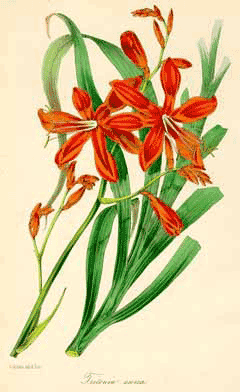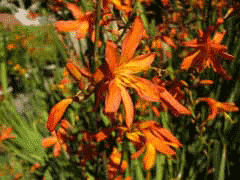 |
|
http://commons.wikimedia.org/wiki/File:Tritonia_aurea_-_Paxton.jpg |
 |
|
Translate this page:
Summary
Physical Characteristics

 crocosmia is a CORM growing to 1 m (3ft 3in) by 0.5 m (1ft 8in) at a fast rate.
crocosmia is a CORM growing to 1 m (3ft 3in) by 0.5 m (1ft 8in) at a fast rate.
See above for USDA hardiness. It is hardy to UK zone 7. It is in flower from July to August. The species is hermaphrodite (has both male and female organs) and is pollinated by Insects.
Suitable for: light (sandy) and medium (loamy) soils. Suitable pH: mildly acid, neutral and basic (mildly alkaline) soils. It can grow in semi-shade (light woodland) or no shade. It prefers moist soil.
UK Hardiness Map
US Hardiness Map
Synonyms
Tritonia aurea
Plant Habitats
Edible Uses
A yellow dye is obtained from the flowers and used as a saffron substitute for colouring foods[61, 177, 183].
References More on Edible Uses
Medicinal Uses
Plants For A Future can not take any responsibility for any adverse effects from the use of plants. Always seek advice from a professional before using a plant medicinally.
None known
References More on Medicinal Uses
The Bookshop: Edible Plant Books
Our Latest books on Perennial Plants For Food Forests and Permaculture Gardens in paperback or digital formats.

Edible Tropical Plants
Food Forest Plants for Hotter Conditions: 250+ Plants For Tropical Food Forests & Permaculture Gardens.
More

Edible Temperate Plants
Plants for Your Food Forest: 500 Plants for Temperate Food Forests & Permaculture Gardens.
More

More Books
PFAF have eight books available in paperback and digital formats. Browse the shop for more information.
Shop Now
Other Uses
References More on Other Uses
Cultivation details
A very easily grown plant, it succeeds in almost all soils other than very heavy clays or bogs[233], though it prefers a light rich sandy soil[1, 79] in full sun or light dappled shade[200, 233]. Another report says that it prefers a fairly shady position and plenty of moisture in the growing season[79]. The corms are hardy to about -10°c[200] but in cold areas it is wise to lift them when the plants die down in the autumn, store them in a cool frost-free place over the winter and plant them out in the spring[1]. Make sure the corms do not dry out[1]. It is best to avoid lifting the corms if at all possible since the new corms seem to derive some nutrition from the old corms that have flowered[200]. Plants can divide quite freely when growing in a suitable location[233]. Although the fresh flowers have no perfume, when dried and immersed in warm water they release a scent like that of the saffron crocus[245]. Members of this genus are rarely if ever troubled by browsing deer or rabbits[233].
References Carbon Farming Information and Carbon Sequestration Information
Temperature Converter
Type a value in the Celsius field to convert the value to Fahrenheit:
Fahrenheit:
The PFAF Bookshop
Plants For A Future have a number of books available in paperback and digital form. Book titles include Edible Plants, Edible Perennials, Edible Trees,Edible Shrubs, Woodland Gardening, and Temperate Food Forest Plants. Our new book is Food Forest Plants For Hotter Conditions (Tropical and Sub-Tropical).
Shop Now
Plant Propagation
Seed - best sown as soon as it is ripe in a cold greenhouse[1]. The seed usually germinates in 3 - 9 weeks at 20 - 25°c[164]. Stored seed can be sown in early spring in a greenhouse[164]. Sow the seed thinly so that the plants can be grown on undisturbed in their pot for the first year, but give the seedlings an occasional liquid feed to ensure they do not become nutrient deficient. Once the plants are dormant in the autumn, pot up the bulbs putting 2 - 3 bulbs in each pot. Grow them on for another year or two in the greenhouse before planting them out when they are dormant in the autumn. Division in spring as new growth commences[200]. Very easy, larger clumps can be replanted direct into their permanent positions, though it is best to pot up smaller clumps and grow them on in a cold frame until they are rooting well. Plant them out in the summer or following spring.
Other Names
If available other names are mentioned here
Native Range
AFRICA: Tanzania, Central African Republic, Democratic Republic of the Congo (east), Angola (east), Mozambique, Malawi, Zambia, Zimbabwe, Lesotho, Eswatini, South Africa (Eastern Cape, Gauteng, KwaZulu-Natal, Limpopo, Mpumalanga)
Weed Potential
Right plant wrong place. We are currently updating this section.
Please note that a plant may be invasive in one area but may not in your area so it's worth checking.
Conservation Status
IUCN Red List of Threatened Plants Status :

Growth: S = slow M = medium F = fast. Soil: L = light (sandy) M = medium H = heavy (clay). pH: A = acid N = neutral B = basic (alkaline). Shade: F = full shade S = semi-shade N = no shade. Moisture: D = dry M = Moist We = wet Wa = water.
Now available:
Food Forest Plants for Mediterranean Conditions
350+ Perennial Plants For Mediterranean and Drier Food Forests and Permaculture Gardens.
[Paperback and eBook]
This is the third in Plants For A Future's series of plant guides for food forests tailored to
specific climate zones. Following volumes on temperate and tropical ecosystems, this book focuses
on species suited to Mediterranean conditions—regions with hot, dry summers and cool, wet winters,
often facing the added challenge of climate change.
Read More
Expert comment
Author
(Pappe. ex Hook.)Planch.
Botanical References
200
Links / References
For a list of references used on this page please go here
Readers comment
| Add a comment |
|
If you have important information about this plant that may help other users please add a comment or link below. Only comments or links that are felt to be directly relevant to a plant will be included. If you think a comment/link or information contained on this page is inaccurate or misleading we would welcome your feedback at [email protected]. If you have questions about a plant please use the Forum on this website as we do not have the resources to answer questions ourselves.
* Please note: the comments by website users are not necessarily those held by PFAF and may give misleading or inaccurate information.
To leave a comment please Register or login here All comments need to be approved so will not appear immediately.
|
|